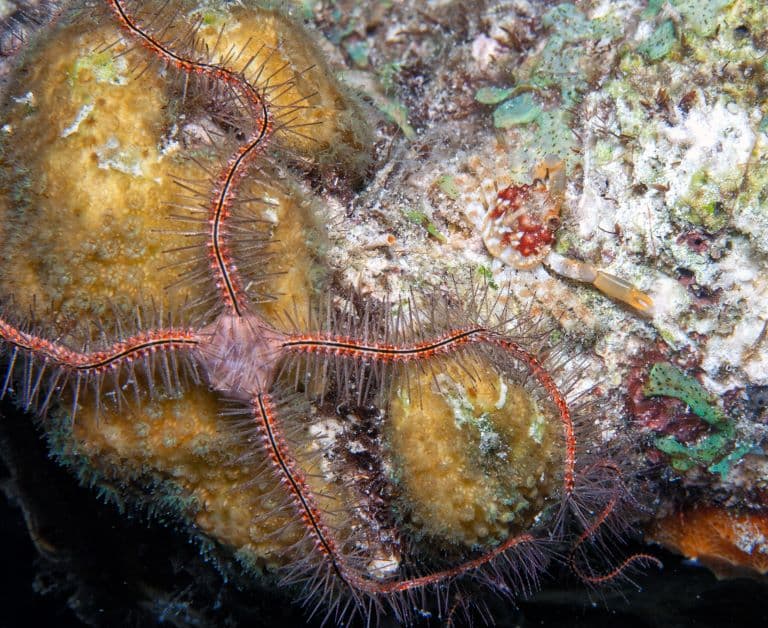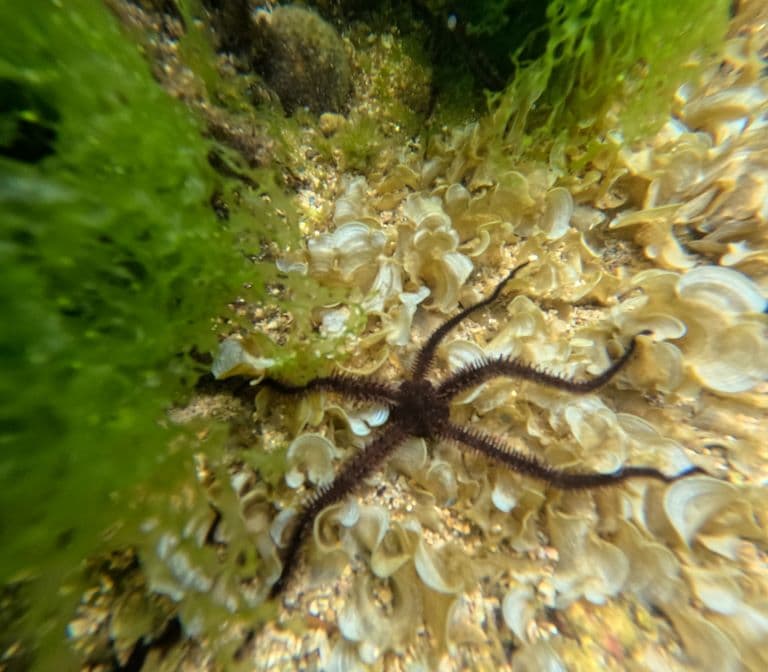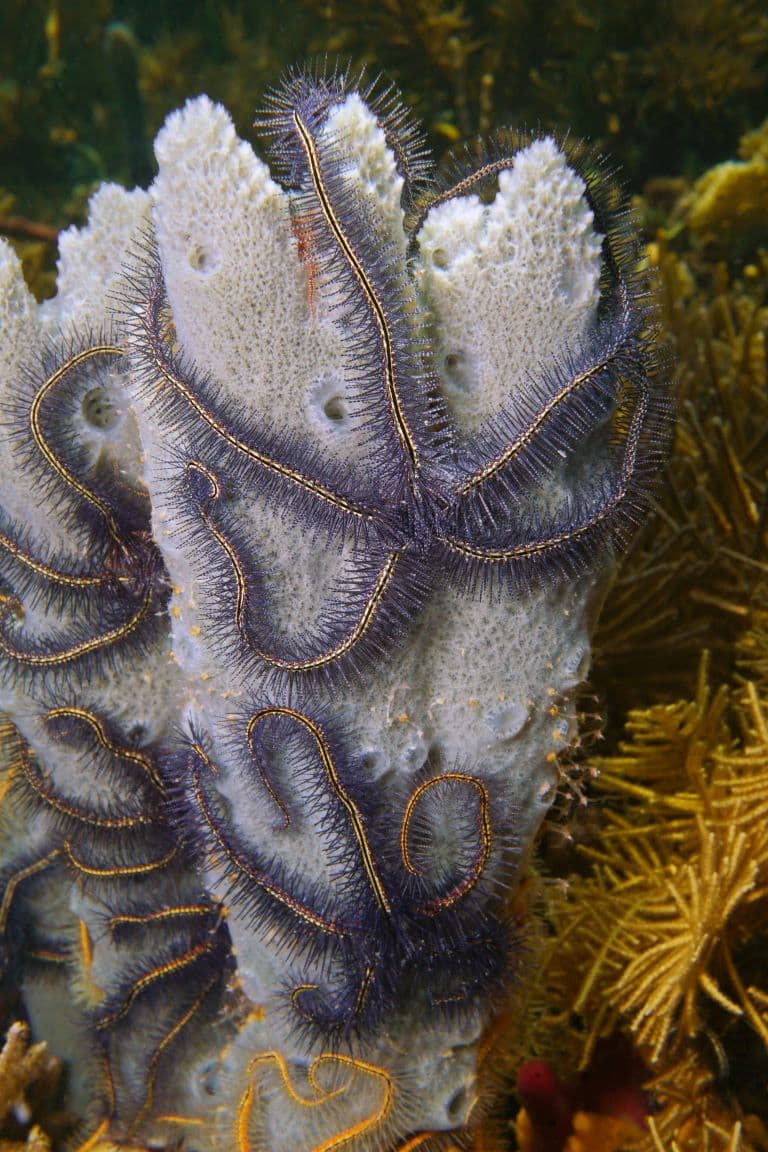Brittle Stars Profile
Most animals we’re used to have limbs and organs reflected by a line of symmetry that goes down the middle.
But this isn’t the norm. In the 19th Century, there was an entire clade of animals known as Radiata, which contained the jellyfish, urchins, and various parasitic worms, defined by their radial symmetry.
But this taxon has been dissolved, and in its place, there’s still quite a mess of confusion. One of the reasons for this is that animals like the brittle stars make us question all kinds of things we once thought were obvious.

Brittle Stars Facts Overview
| Habitat: | Marine, from shallow to deep water |
| Location: | Worldwide |
| Lifespan: | Most up to 5 years. |
| Size: | 2.5 cm (1 in) to 60 cm (2 ft) across, depending on species |
| Weight: | Not recorded |
| Colour: | Hugely varied, dull brown to purple, red, orange and yellow, striped |
| Diet: | Mostly detritus, some carnivorous |
| Predators: | Crustaceans, fish, other echinoderms |
| Top Speed: | Slow |
| No. of Species: | 2000 + |
| Conservation Status: | Not listed |
Brittle stars are radially symmetrical, but they’re also not. They reproduce sexually, but sometimes break in half and clone themselves.
They are detritus feeders, except when they hunt, and they love shallow waters when they’re not enjoying the abyssal depths of 6km down. They are part of the largest marine phylum there is and separated from our evolutionary path by about 540 million years.
As possibly the most widespread and diverse echinoderms, brittle stars still have so much to teach us about the definitions of life.
Interesting Brittle Stars Facts
1. They’re Echinoderms
The Echinodermata are familiar to all of us, even if the name isn’t. This is a phylum that sounds like the Kiswahili for “No worries”, and it includes the urchins, starfish and other radially symmetrical animals.
Brittle stars are a class of echinoderm, most closely related to starfish, and similar in appearance, despite diverging from their cousins around 480 million years ago, before trees existed.
In that time, they have radiated and diversified into over 2,000 known species, found all over the world’s seas and oceans, and at every depth below the tidal line. They have even occupied brackish waters.
This phenomenal radiation may explain why, around 250 million years ago, there was a rapid explosion in shell-crushing predators that didn’t exist before.
Members of the brittle star order differ from starfish in their lack of sticky feet, and a defined disc that separates their arms from their bodies. As adults, they typically have five of these arms, all revolving around a central point. 1

2. They’re (eventually) radially symmetrical
The majority of this order have five arms, and this gives them what’s known as pentaradial radial symmetry.
Unlike those of us with a line down the middle, these are star-shaped animals, with all the organs clumped into the central disc, and a central mouth with five toothed jaws.
But despite this clear star quality, the echinoderms are grouped well within the infrakingdom of Bilateria: a clade of animals characterised by their bilateral symmetry, and one that includes all vertebrates, including humans.
This is because Bilateria is defined by the embryonic development of an animal, and even after they are born, brittle stars retain signs that their ancestors were members.
Baby brittle stars have a distinctive larval stage called an ophiopluteus. This stage looks remarkably like a skydiving spider, with six limbs – three on each side.
It’s only when they mature that these limbs mutate and form a radial star, so this morphology is distinct from truly round animals like the Cnidarians. 2
3. They’re hydraulic
Brittle stars still differ quite a bit from a lot of the bilateral animals we are familiar with. One stark contrast is their water vascular system, which functions in echinoderms like the hydraulic process in a spider’s legs, extending limbs by forcing fluid into them.
But it also functions as a circulatory system and carries nutrients, waste and respiratory gases around the animal’s body. 3

4. They do pretty much everything with their legs
The special way brittle stars move their bodies allows them a higher degree of dexterity than the relatively slow starfish, and their entire sensory system seems to be related to their limbs, too.
Most brittle stars have no eyes at all, but instead feel, taste, and smell using their arms. They can even “feel” the presence of light using the tips of their appendages.
Their locomotion also belies their bilateral origin, with one leg usually pointing forward to act as the axis of symmetry, either side of which their two pairs of legs function with the coordinated gait of a four-limbed animal.
When they want to turn, instead of rotating their bodies, they simply re-assign a limb to be the head. 4

5. And everything else is in the disc
Starfish have arms and bodies that are more or less overlapping. But brittle stars have a distinct separation between the two, so whatever isn’t happening in the arms happens in the disc.
This is where the gonads are found, and where all the digestive organs are housed. On the surface facing the ground, there’s a mouth. And this mouth doubles up as a butthole.
6. They poop with their mouths
The mouth of brittle stars has five jaws, which is already pretty cool, but it’s also used as an anus, which means their anus, too, has five jaws.
Behind these jaws, there’s a series of around ten little stomach pouches where digestion happens.
When that’s done, the pouches turn inside out and poop waste products through the same opening. Most of what goes is in just leftover organic matter from the chaos of the oceans, but some species don’t settle for scraps and make their own food. 5
7. Some are carnivorous
Some species, like the monstrous Ophiosparte gigas, are so formidable as predators that they’re at the top of the food chain in their habitats.
Granted, they have to live where sharks, crabs or fish are absent, but when you remove all these, the apex predator is sometimes a brittle star.
They will follow chemical trails and chase down prey (albeit slowly), which they then devour using five scary-looking jaws.
8. Some can split in half
Another way in which these stars are full of surprises is in their choice of reproduction. Most species sexually reproduce, but some simply break in half when they want to make more.
In some six-armed species, the disk softens in the middle, then half of it breaks away, creating two individuals, both with three arms.
From there, three new arms begin to grow, giving them both a wonky look until the arms reach maturity.
Other species do this only when they struggle to find a sexual partner, something which remains the less appealing option across much of the animal kingdom.
Given the rate of fission events, it’s possible a single brittle star can spawn 15 more within a year this way.
9. Some glow-in-the-dark
It should be no surprise by now that there are many documented species of brittle stars that produce bioluminescence.
The purpose is still a bit of a mystery, and both deep and shallow-water species do it.
Brittle Stars Fact-File Summary
Scientific Classification
| Kingdom: | Animalia |
| Phylum: | Echinodermata |
| Class: | Ophiuroidea |
| Order: | Six orders |
| Family: | Sixteen families |
Fact Sources & References
- Luis A. Buatois (2016), “The Mesozoic Marine Revolution”, Springer Link.
- “Invertebrates in the Plankton: Echinodermata”, Depts Washington.
- Anna Czarkwiani (2022), “Neurogenesis during Brittle Star Arm Regeneration Is Characterised by a Conserved Set of Key Developmental Genes”, NIH.
- Wynne Parry (2012), “Brittle Stars Move Like Humans”, Live Science.
- “Brittle Stars”, Marine Education Society of Australasia.
